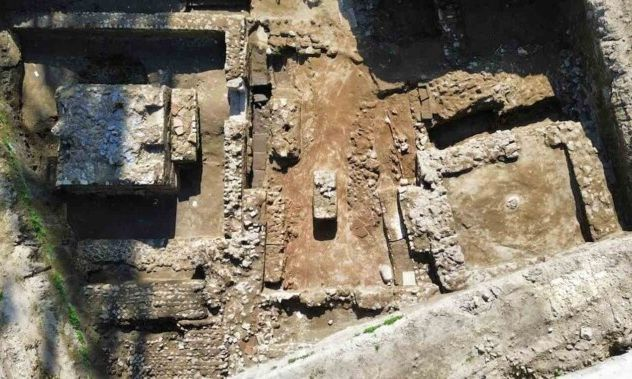Northern Spain's Estatuas cave was a hub of activity 105,000 years ago. Its Neanderthal residents may have constructed fires, butchered red deer, and hafted stone tools, according to artifacts. Subtler traces of their DNA were also ejected, bled, and excreted onto the cave floor. "You can picture people working in the cave, chopping up animals and manufacturing tools. The perspective of population geneticist Benjamin Vernot, a postdoc at the Max Planck Institute for Evolutionary Anthropology (MPI-EVA), may have been influenced by the sounds of his own infant during a Zoom conversation. "Maybe they cut themselves or their babies pooped," he speculates. "The dirt floors accumulate all that DNA."
Researchers excavating Estatuas cave in Spain found a long record of Neanderthal DNA in the sediments.© JAVIER TRUEBA/MADRID SCIENTIFIC FILMS
The first ancient human's nuclear DNA has been extracted from sediments, according to his and MPI-EVA biologist Matthias Meyer's paper published today in Science. The human mitochondrial DNA (mtDNA) found on cave floors was previously reported to be shorter and more plentiful, but nuclear DNA, which was previously only found in bones and teeth, can be far more illuminating. According to Leiden University archaeologist Marie Soressi, "Now, it seems that it is possible to extract nuclear DNA from dirt, and we have a lot of dirt in archaeological sites."
Population geneticist Pontus Skoglund of the Francis Crick Institute concurs, calling this a "beautiful paper." The genetic identity and sex of prehistoric cave inhabitants are revealed by the sequences, which also demonstrate that one group of Neanderthals replaced another in the Spanish cave around 100,000 years ago, possibly as a result of a cooling of the temperature. "They can see a shift in Neanderthal populations at the very same site, which is quite nice," adds Skoglund.
Only 23 ancient humans, including 18 Neanderthals from 14 locations across Eurasia, have had their ancient DNA recovered from their bones or teeth thus far. Vernot and Meyer's team analyzed silt from precisely dated levels in three caves known to have been inhabited by prehistoric humans: the Denisova and Chagyrskaya caves in Siberia, as well as the Estatuas cave in Atapuerca, Spain.
In what Skoglund refers to as "an amazing technical demonstration," they created new molecular probes to fish out human DNA while ignoring the numerous sequences from plants, animals, and microorganisms. They next employed statistical techniques to isolate Neanderthal-specific DNA and compare it to reference Neanderthal genomes in a phylogenetic tree.
All three locations produced Neanderthal nuclear and mtDNA, although Estatuas cave's little amount of nuclear DNA from several Neanderthals surprised researchers the most. Nuclear DNA from a male Neanderthal from the deepest layer, dated to around 113,000 years ago, connected him to the earliest Neanderthals who lived in the Denisova cave and caves in Belgium and Germany around 120,000 years ago.
According to co-author and paleoanthropologist Juan Luis Arsuaga of the Complutense University of Madrid, two female Neanderthals who lived in Estatuas cave later, around 100,000 years ago, had nuclear DNA that more closely matched that of later, "classic" Neanderthals, including those who lived less than 70,000 years ago at Vindija cave in Croatia and 60,000 to 80,000 years ago at Chagyrskaya cave.
At the same time, diminishing diversity may be seen in the more prevalent mtDNA from Estatuas cave. In the cave 113,000 years ago, Neanderthals had at least three different forms of mtDNA. But there was just one type of Neanderthal in the cave between 80,000 and 107,000 years ago. Ancient DNA found in Neanderthal bones and teeth has previously indicated a decline in genetic diversity during the same time period.
According to Arsuaga, Neanderthals flourished and expanded their range during the warm, humid interglacial period that began 130,000 years ago. But as a new glacial epoch began around 110,000 years ago, temperatures in Europe abruptly dropped. All but one lineage of Neanderthals vanished shortly after then. During subsequent, warmer periods, members of the surviving lineage began to repopulate Europe, some of whom sought refuge in Estatuas cave.
The "famous" classic Neanderthals, such the skulls from France's La Ferrassie and Vindija, are among those survivors and their offspring, according to Arsuaga. Compared to older Neanderthals, whose cranial capacity were no greater than 1400 cm3, he writes that they possessed brains up to 1750 cubic centimeters (cm3). The advent of the cold age, according to Arsuaga, also caused a rise in brain size and several population replacements in modern humans in Africa.
In humans or other mammals, "we find this pattern almost everywhere we look," according to Beth Shapiro, a genetic researcher at the University of California, Santa Cruz. "Dispersal over perhaps long distances and population replacement or admixture."
DNA from cave dirt is expected to produce more hints. Paleogeneticist Viviane Slon, a current Tel Aviv University employee and co-author of the Science publication, claims that she and the MPI-EVA team are examining ancient DNA from sediments at numerous locations across the world. "Hopefully soon, we'll start to get a very high-resolution, fine-scale view of ancient humans and who was where at what time," adds the researcher.







